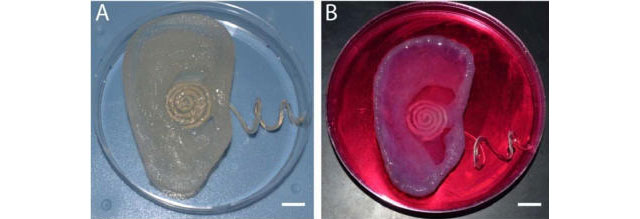A lot of you may not have ever seen this old tv show which lasted about 4-years in the ’70’s. Called “The Six Million Dollar Man” it’s premise was simple:
After a crippled test pilot is rebuilt with nuclear powered limbs and implants, he serves as a unique intelligence agent.
Taking into consideration the impact of inflation on our economy, in 2013 he’d probably be called the 60-billion dollar man. You know, cost overruns, occasional Union strikes and overly moral scientists who quit the project midway are included in the new figure.

Well, eggheads at Princeton University used a bunch of off-the-shelf printing gizmos to develop an ear from scratch that that can actually “hear” noises that go well beyond what a normal human being is designed to pick-up.
Wait: What?
You may have heard of the latest craze called 3-D printing. Actually, it’s been around for a couple of decades. But now it’s cheap enough that a well-to-do family guy can buy one.
Anywho, these scientists thought, in so many words, maybe it would be neat if we could blend human tissue with electronics. They fired-up their 3-D printer using cells and nanoparticles instead of some kind of plastic pebbles. Then once the cells were printed, they put the goo in a cell culture to mix a small coil antenna with cartilage.
Voila! A bionic ear.
Princeton Scientist Speaks
According to a statement published through the university’s PR arm:
“In general, there are mechanical and thermal challenges with interfacing electronic materials with biological materials,” said Michael McAlpine, an assistant professor of mechanical and aerospace engineering at Princeton and the project’s lead researcher. “Previously, researchers have suggested some strategies to tailor the electronics so that this merger is less awkward. That typically happens between a 2-D sheet of electronics and a surface of the tissue. However, our work suggests a new approach — to build and grow the biology up with the electronics synergistically and in a 3-D interwoven format.”
This guy has done other brain-exploding things, too. Like when he, Naveen Verma, an assistant professor of electrical engineering, and Fio Omenetto of Tufts University, came up with the idea of making a “tattoo” that can be stuck on a person’s tooth to become a biological sensor and antenna. This is meant to monitor a person’s health by picking-up signals from your teeth.
The Last Word
Princeton finally explains the entire schmear:
“The finished ear consists of a coiled antenna inside a cartilage structure. Two wires lead from the base of the ear and wind around a helical “cochlea” — the part of the ear that senses sound — which can connect to electrodes. Although McAlpine cautions that further work and extensive testing would need to be done before the technology could be used on a patient, he said the ear in principle could be used to restore or enhance human hearing. He said electrical signals produced by the ear could be connected to a patient’s nerve endings, similar to a hearing aid. The current system receives radio waves, but he said the research team plans to incorporate other materials, such as pressure-sensitive electronic sensors, to enable the ear to register acoustic sounds.”
Wanna see the guy who is responsible for the bionic ear. Here’s a video which details what his team did:
Kudos also goes to a really smart kid. On board was a teenager named Ziwen Jiang, a high school student at the Peddie School in Hightstown. As McAlpine says, “Ziwen Jiang is one of the most spectacular high school students I have ever seen. We would not have been able to complete this project without him, particularly in his skill at mastering CAD designs of the bionic ears.”
Give the young man a scholarship! Rah! Tiger sis boom bah!
Original Source: http://austinentmd.com
Image Source: 3dprintingindustry.com

